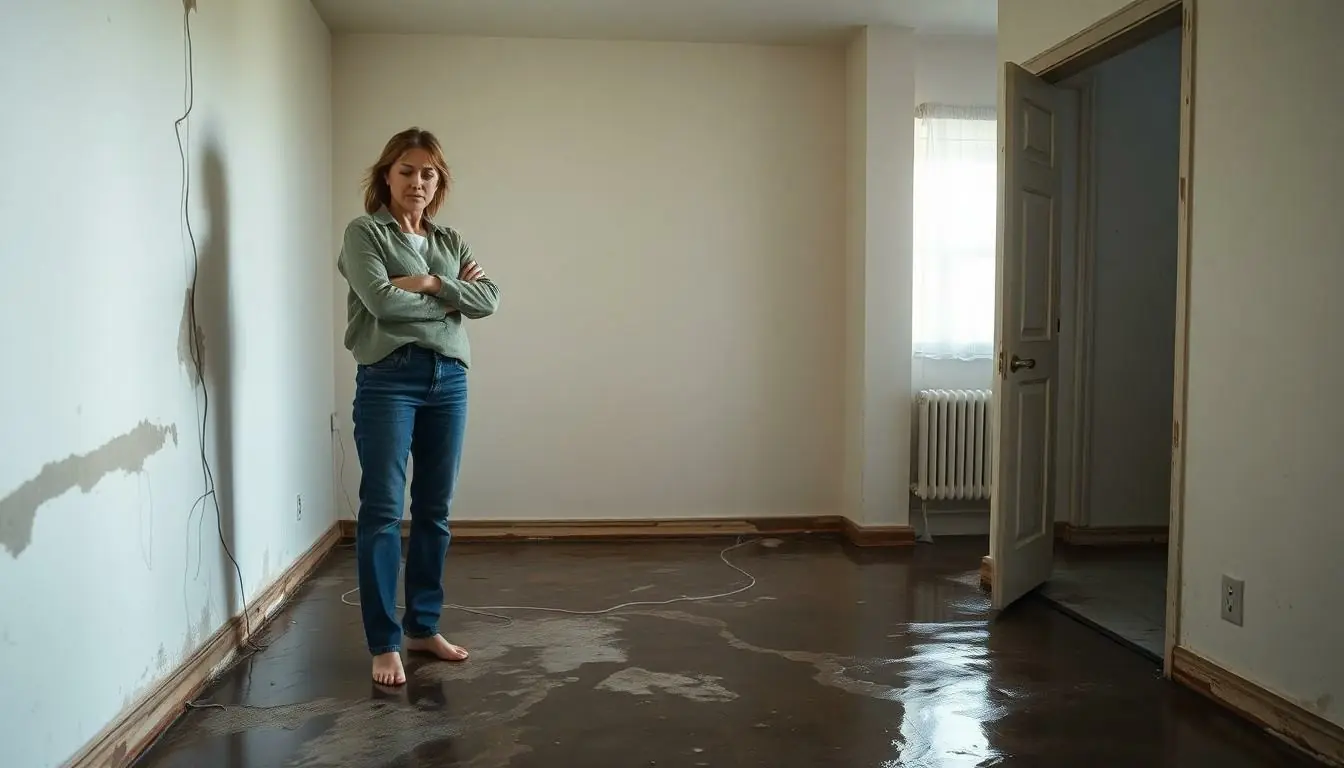Water damage can feel like an unwelcome guest crashing your home party. Just when you think everything’s going smoothly, a leaky roof or a burst pipe shows up, soaking your plans and your living room. So, how long does a landlord have to fix this soggy situation? It’s a question that many tenants find themselves asking while staring at a ceiling that resembles a water park attraction.
The good news is that landlords usually have a legal obligation to address these issues in a timely manner. But what does “timely” really mean? The answer can vary based on local laws and the severity of the damage. In this article, we’ll dive into the specifics, helping tenants understand their rights and encouraging landlords to take action before their properties start resembling a scene from a disaster movie.
Table of Contents
ToggleUnderstanding Water Damage
Water damage refers to harm caused by the intrusion of water into spaces where it can lead to destruction. Sources of water damage often include leaks from pipes, heavy rainfall, or flooding. Each event can result in various levels of damage, impacting structural integrity and health conditions.
Landlords must understand local laws regarding water damage repairs. They generally possess a legal responsibility to address such issues quickly. Timeliness of repairs varies based on the severity of the damage and local regulations. For example, minor leaks might warrant a repair time of several days, while extensive flooding can necessitate immediate action to mitigate mold and mildew risks.
Tenants should communicate promptly when they notice water damage. Documentation through photographs and written notifications often supports claims of damage severity. Prompt notification ensures landlords can assess and respond to issues as needed.
Landlords can benefit from developing effective maintenance protocols. Regular inspections of plumbing and roofing systems can prevent unforeseen water damage. Keeping an open line of communication with tenants encourages timely reporting, which can minimize long-term damage.
Understanding the implications of water damage is crucial for both landlords and tenants. Tenants need to know their rights and responsibilities regarding maintaining their living environment. Landlords must prioritize timely repairs to uphold property standards and keep tenants satisfied.
Legal Responsibilities of Landlords

Landlords hold specific legal responsibilities regarding repairs to water damage. These duties often hinge on state regulations and the nature of the damage itself.
State-Specific Regulations
State laws govern what landlords must address when it comes to water damage repairs. For instance, some states require landlords to respond within a specific timeframe, typically ranging from 24 hours to 14 days. In California, landlords must act within a reasonable time, but no exact timeframe is specified. New York mandates repairs within a reasonable duration as well, yet the definition of “reasonable” may vary. Local ordinances can further influence these requirements. Tenants must understand their state’s laws to assert their rights effectively.
General Timeframes for Repairs
General repair timelines for water damage depend on severity. Minor issues, like small leaks, might require a landlord to fix them within a few days. More serious cases, such as extensive flooding or structural damage, demand immediate action to mitigate risks like mold growth. Generally, landlords must address emergencies swiftly, typically within one to three days. Non-emergency repairs usually have more flexible timelines, often extending to a week or longer. Tenants should report damage quickly and follow up appropriately to ensure compliance with these timeframes.
Tenant’s Rights and Responsibilities
Tenants play a crucial role in addressing water damage issues effectively. Understanding their rights and responsibilities ensures a smoother resolution process.
Reporting Water Damage
Reporting water damage immediately remains essential. Tenants should notify their landlord in writing, providing specific details about the issue. Including photographs helps document the extent of damage clearly. Utilizing text or email can serve as a record of communication. Most states require tenants to report problems to allow landlords to fulfill their responsibilities. Failing to report damage can lead to further complications, like additional damage or even legal disputes. Keep a copy of all communications for future reference. Quick reporting can expedite necessary repairs and minimize damage.
Following Up on Repairs
Following up on repairs is just as important as reporting water damage. After notifying the landlord, tenants should check in regularly about the status of repairs. Making calls or sending emails demonstrates a proactive approach. Landlords often appreciate reminders, especially for non-emergency situations. Tenants could inquire about the timeline for repairs, which often hinges on state regulations. Requesting updates might reveal delays or further actions required on the tenant’s part. Documenting each follow-up reinforces the tenant’s commitment and preserves their rights. Staying engaged helps ensure that repairs proceed as necessary.
Consequences of Delayed Repairs
Delayed repairs of water damage can lead to significant complications for both tenants and landlords. Mold growth often arises within 24 to 48 hours after water exposure, increasing health risks. Health issues such as respiratory problems and allergies become more prevalent among tenants when mold is present.
Property damage also escalates with time. Structural elements of the building, like walls and flooring, deteriorate further, leading to costly repairs. As time passes, landlords may incur higher repair expenses, which could have been avoided with timely action.
Legal ramifications can also affect landlords who neglect repair responsibilities. In many jurisdictions, lease agreements stipulate timely repairs, and failure to comply can result in legal disputes. Tenants may seek remedies through small claims court, impacting the landlord’s reputation and potentially leading to financial liability.
Tenant dissatisfaction increases when repairs are delayed. Frustration may result in tenants seeking relocation, which disrupts the landlord’s rental income. Communication lapses during repair timelines can further strain the landlord-tenant relationship, underscoring the importance of transparency.
Future rental prospects may be jeopardized due to neglectful maintenance. Prospective tenants often research landlords’ reputations, and delayed repairs can garner negative reviews. Maintaining property standards becomes essential for attracting reliable tenants and ensuring consistent occupancy.
Awareness of these consequences emphasizes the importance of prompt action for landlords. Landlords benefit from prioritizing repairs, as timely interventions preserve property integrity and tenant satisfaction. Proactive measures prevent escalating issues, safeguarding both parties involved.
Tips for Tenants Dealing with Water Damage
Document water damage immediately. Take photographs to capture the extent of the issue, as this serves as vital evidence for any future claims.
Notify the landlord in writing. Clear communication is essential. Include specific details about the damage, such as the location and suspected cause, to facilitate a swift response.
Keep records of all communications. Note dates, times, and responses from the landlord. This provides a timeline of events that may be helpful if disputes arise.
Follow up on repairs regularly. Checking in on scheduled repairs shows initiative and reinforces the request for prompt action. Staying informed keeps the resolution process on track.
Know your rights. Research local laws and regulations regarding water damage, as these vary significantly. Understanding these regulations equips tenants with the knowledge needed to advocate for timely repairs.
Understand the risk of mold. Mold can develop within 24 to 48 hours of water exposure. Being aware of this risk emphasizes the urgency for landlords to act quickly.
Explore temporary solutions. While waiting for repairs, consider using fans or dehumidifiers to minimize moisture. This can help prevent further damage to personal belongings and the property.
Seek assistance if necessary. If a landlord delays repairs without justification, tenants may consider contacting local housing authorities or legal aid organizations. These resources can provide support in understanding rights and possible next steps.
Recognize potential health impacts. Water damage can lead to health problems, particularly respiratory issues, underscoring the need for landlords to address the situation swiftly. Tenants should prioritize their safety and well-being throughout the process.
Addressing water damage promptly is essential for both tenants and landlords. Timely repairs not only protect the property but also safeguard tenant health and well-being. Landlords must be aware of their legal obligations and the varying timelines based on local regulations and the severity of the damage.
Tenants play a crucial role by reporting issues immediately and documenting their communications. This proactive approach fosters a collaborative environment that can lead to quicker resolutions. Ultimately, swift action benefits everyone involved, preserving property value and ensuring tenant satisfaction.







